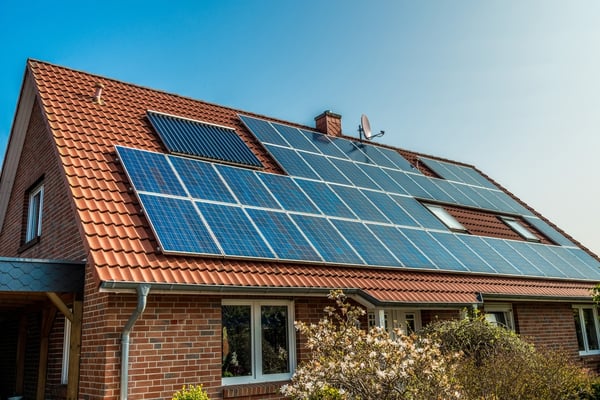Overview of the New Jersey Solar Renewable Energy Credit Program

Many states in the USA have introduced laws called Renewable Portfolio Standards, with the goal of increasing their share of renewable generation and reducing their carbon footprint. An RPS law establishes a minimum renewable generation percentage for all electric utility companies in the state, and there are significant fines for non-compliance. The RPS target for New Jersey is 22.5% by 2021, with a specific solar power target of 4.1% by 2028. A Solar Renewable Energy Credit (SREC) program has been created to help reach that target, which will be explained in this article.
New York also has an RPS law with a target of 50% by 2030, although there is no specific solar power target. There is no SREC program in New York, but solar rebates are available through the NY-Sun incentive program managed by NYSERDA.
Get an assessment of your building to determine the best energy performance upgrades.
How Does a SREC Program Work?
To understand how a SREC program works, it is important to distinguish between the two main types of solar power users:
- Energy companies that are forced to reach a renewable energy target, according to the RPS law.
- Homeowners and businesses who deploy solar power to reduce their energy expenses, and who are not forced to reach the RPS target.
For each household or commercial building equipped with a renewable energy system, the load on the power grid is reduced. Therefore, solar power systems on client premises can be counted towards the renewable energy target; however, since the investment was assumed by consumers, energy companies must pay for the right to count that capacity as their own. This is accomplished with Solar Renewable Energy Credits (SREC):
- Homes and businesses with solar PV systems accumulate them.
- Utility companies purchase them, which counts towards their own RPS target.
Note that homes and businesses are not selling energy from PV systems when they sell SRECs; these credits represent proof of having generated clean energy, without involving an actual energy transaction. Solar PV system owners can continue using the energy produced, even if the corresponding SRECs are being sold. Any surplus generation can be exported to the power network in exchange for a power bill credit, which is independent from SREC sales.
How Much Are SRECs Worth?
For every 1,000 kilowatt-hours generated by a solar PV system, the owner gets one SREC. This means a larger installation accumulates SRECs faster: a small residential system will likely accumulate less than 10 SRECs in a year, while a large commercial installation can accumulate several dozens of them. SREC prices are like stock market prices, determined by supply and demand. However, as of 2018 they are being traded for more than $200/SREC, occasionally going above $230/SREC.
Since you get one SREC for every 1,000 kWh of generation, the extra economic benefit is over 20 cents per kWh. Consider that this represents additional income beyond the normal energy savings achieved with your photovoltaic array:
- Assume your average electricity tariff is 16 cents/kWh.
- Add 20 cents/kWh corresponding to SREC sales.
- The resulting economic benefit for solar generation is 36 cents/kWh.
Both the electricity tariff and the SREC price may vary, but this example gives a general idea of the potential economic benefit. The SREC program shortens the payback period of a solar photovoltaic system, while increasing the return on investment.

How Are SRECs Accumulated and Sold?
Installing a PV system does not qualify the owner for SREC accumulation automatically - there is paperwork to complete. Applicants must submit their project for approval through the SREC Registration Program (SRP), and the NJ Clean Energy Program provides an online portal to start the application. Five conditions must be met before a solar power system can start producing SRECs for its owner:
- Registration accepted.
- Installation completed.
- Final paperwork accepted.
- Authorization from the corresponding electric distribution company.
- Having a revenue-grade power meter, compliant with ANSI Standard C12.1-2008. Note that this meter is separate from the one provided by the utility company.
Once the conditions above are met, the user can open an account in the SREC Tracking System. For every 1,000 kWh of production measured by the approved power meter, one SREC is earned and deposited into the account. Once approved, a solar PV system can earn SRECs during a 15-year period.
Selling SRECs to utility companies is lucrative, but it involves plenty of additional paperwork. Owners of large commercial and industrial PV installations can consider handling the sale themselves, to get the full economic benefit each SREC. On the other hand, homeowners and small businesses can consider selling through SREC brokers who handle the paperwork, saving valuable time.
Note that SRECs are earned by the legal owner of a solar photovoltaic system: you can get them if you purchase the solar PV system in cash or through a loan. However, if you are leasing a PV array, the lease provider gets the SRECs. The same applies if you sign a solar Power Purchase Agreement (PPA), which is similar to a lease, with the difference that you pay a variable fee based on energy generation and not a fixed rent.
Final Recommendations
Solar power is already cost-effective by itself, but the SREC program in New Jersey makes PV systems much more lucrative. In addition to reducing power bills, they provide additional income for 15 years in the form of SREC sales. Just keep in mind there is an approval procedure to follow, which includes as-built documentation for the solar photovoltaic array - having a properly designed and installed system is very important.

Michael Tobias
Michael Tobias, the Founding Principal of NY Engineers, currently leads a team of 150+ MEP/FP engineers and has led over 4,000 projects in the US
Join 15,000+ Fellow Architects and Contractors
Get expert engineering tips straight to your inbox. Subscribe to the NY Engineers Blog below.

